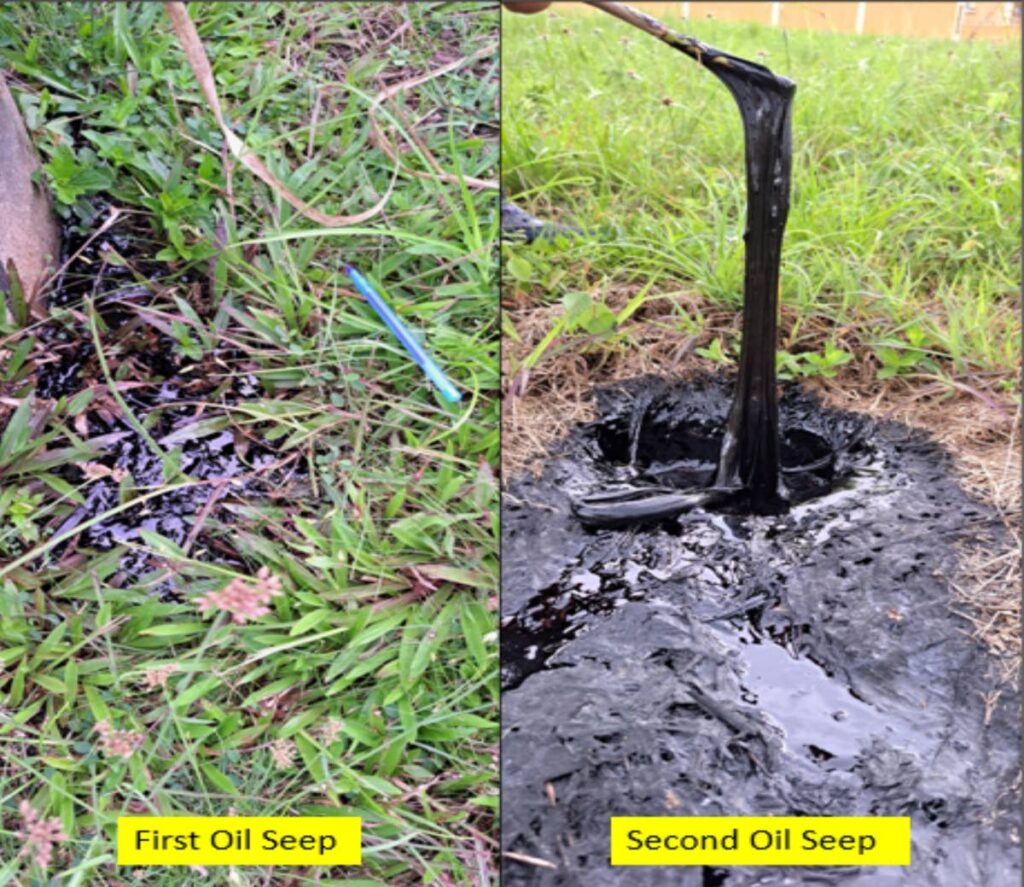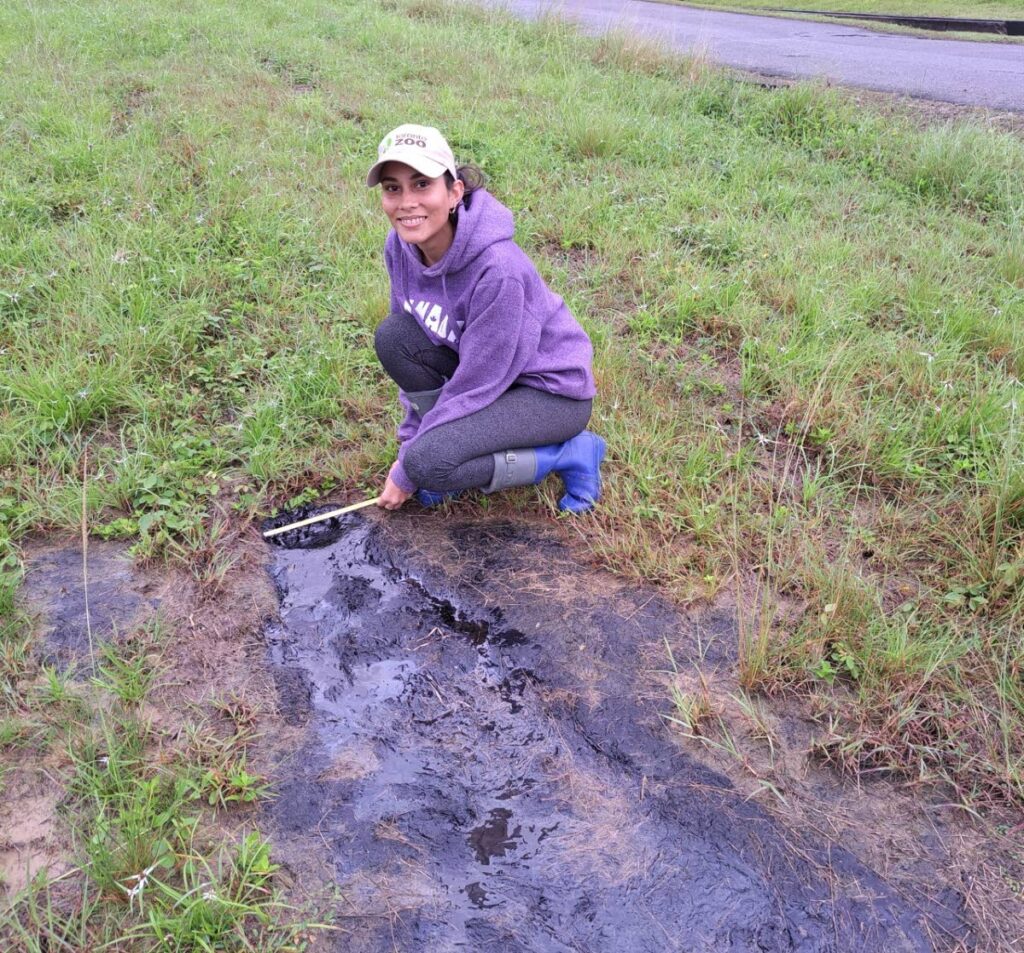Double oil-seep discovery in Gopaul Lands

GEOLOGICAL SOCIETY OF TT
My name is Christie Carr, a 26-year-old geoscientist. I graduated from UWI, St. Augustine in 2021 where I did my BSc in petroleum geoscience. In October 2022, I was elected a director of the Geological Society of TT. I have been interested in earth sciences all my life and I love to explore and document my findings. I live in Marabella, in the Gopaul Lands area. A quiet residential area with roads going uphill and downhill making it the perfect course for all the driving schools and those who enjoy daily walks. In the middle of the area there is also a relatively large hill occupied by several houses but still remains partially covered with tall grassy vegetation. This natural landmark stands out from the highway and is visible from any height outside the area. One day, what started out as a regular afternoon walk with my dad and my dog turned into an adventure of discovery and curiosity. I not only was able to come across one, but two oil seeps within a period of a few weeks. Our country is well known for its involvement in the oil and gas industry with several oil and gas fields scattered both onshore and offshore. In order for the hydrocarbons to accumulate in these areas, it has to first migrate through pathways usually created by faults and fractures below. Sometimes, there can be a natural leak to the surface leaving behind a puddle of oil that we then refer to as an oil seep.
Having been a petroleum geoscience student, I would very often look at this same large hill and wonder if that feature perhaps could contain any oil due to its shape and resemblance to an anticline, which is a term used to describe a major fold in a rock, forming a crest where oil and gas would usually accumulate, so I would jokingly explain to my mom where the oil would be if in fact there was any. It was not until I was out one afternoon when I glanced the ever so small black patch near the rim of a concrete water well. Immediately I rushed over, excitedly saying “I think that’s oil!” and to my surprise it was.
Located at the roadside just at the base of the gently dipping hill was a small seep with oil slowly escaping through the patch of grass. A few weeks later my dad comes home and says he observed what he thinks is another black spot not too far from the first which could be another oil seep. Upon investigating, I could confirm it was in fact another seep. Now this second oil seep was located near the first and was visible from the roadside as it was higher up the slope. Since the area is filled with empty lots of land, the bushy tall grass takes over and is usually cut more often during the rainy season causing this seep to now be very visible to neighbours and curious passersby. Unlike the first seep, this one was more of a small round puddle with no grass being overgrown making it quite easy to reach in with a stick and pull up some of the thick black sticky oil.

Over the course of about three months, I would regularly stop and observe both seeps, taking pictures, a sample or two, GPS readings and measurements all while making mental notes of any changes I saw, since after all I learned from the best during fieldwork.
Over the few months that observations were made at the first oil seep, there was no visible change to its size as it appeared to be untouched and unchanged with the only thing growing being the grass around it.
The second oil seep appeared huge from the roadside, however the actual area where the oil was escaping was only a few inches wide. However, the distance where oil would have been flowing was recorded as 10.5ft but just over two weeks before it was approximately 7ft, telling us a bit about the rate the oil would flow out since here it appeared to be more mobile given that there was no grass growing within the seep itself, allowing the oil to escape freely and gradually ooze down the side of the hill. Frequent large bubbles were also observed indicating some amount of gas was also being expelled.
When compared to the geological map of Trinidad it was found that the oil seeps may fall within the Nariva Formation which, if in fact true, would mean that this area is made up of Late Oligocene to Early Miocene deposits comprising of “dark grey to brown, non-calcareous, sometimes well-bedded claystones, thin to thick sandstone units and intermittent thin carbonaceous lignite beds."
With that being said, there were no nearby exposed rock to observe but what is interesting is that these oil seeps occur close to the San Fernando Hill and is adjacent to a major fault known as the Naparima Hill Thrust which cuts across a large portion of the country. Though a small distance away from the actual fault, it is possible that with the presence of this thrust feature, there would have been heavy fracturing trending alongside it, allowing some amount of oil from any nearby source to slowly migrate through these fractured pathways and eventually appear as these oil seeps. There are several oil seeps of varying sizes around the San Fernando Hill area, so it is not uncommon at all but still, a very unique and quite unexpected sight for the residents in Gopaul Lands. I will continue exploring as I do believe there could be other oil seeps in the area but until then it is my hope that I can get some samples tested and uncover a bit more on these features.


Comments
"Double oil-seep discovery in Gopaul Lands"